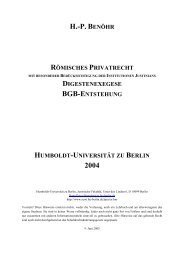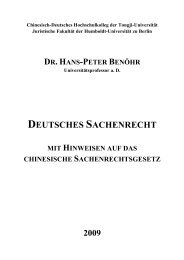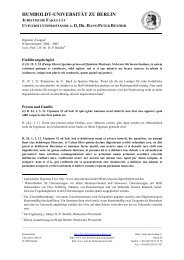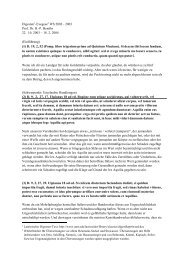Prof. em. Dr. Hans-Peter Benoehr Humboldt-University Law School ...
Prof. em. Dr. Hans-Peter Benoehr Humboldt-University Law School ...
Prof. em. Dr. Hans-Peter Benoehr Humboldt-University Law School ...
You also want an ePaper? Increase the reach of your titles
YUMPU automatically turns print PDFs into web optimized ePapers that Google loves.
<strong>Prof</strong>. <strong>em</strong>. <strong>Dr</strong>. <strong>Hans</strong>-<strong>Peter</strong> <strong>Benoehr</strong><strong>Humboldt</strong>-<strong>University</strong> <strong>Law</strong> <strong>School</strong>Berlin / GermanyIntroduction to InternationalEconomic <strong>Law</strong>Part 4Developing CountriesTeaching MaterialsBENOEHR.REWI.HU-BERLIN.DEHANS-PETER.BENOEHR@GMX.DEShanghai 2012
4(3) Developing CountriesThe great number of developing countries are developed up to different degrees.Article XVIII GATT 1947 described developing countries as those „economies…which canonly support low standards of living and are in the early stages of development“.(4) Less Economically Developed CountriesThe poorest nations which can in no sense be regarded as developing.In Asia: Afghanistan, Cambodia, Laos. Most countries in Africa.Criticisms of TerminologyThe term ‘developing country’ implies inferiority compared to a 'developed country'.It assumes a desire to ‘develop’ along the traditional 'Western' model of economicdevelopment which a few countries, such as Cuba, have chosen not to follow.The term 'developing' implies that the country is moving from a low standard to a higherstandard. But in some cases, the country’s level stagnates or even declines, and there is nomov<strong>em</strong>ent to a higher standard at all.The term implies homogeneity between such countries. But in reality, the nature ofdeveloping countries varies widely.CHAPTER 3. DEVELOPMENTTerminologyDevelopment aid or development cooperation (also development assistance, technicalassistance, international aid, overseas aid, Official Development Assistance (ODA) or foreignaid) is aid given by governments and other agencies to support the economic, environmental,social and political development of developing countries. The term development cooperation,which is used, for example, by the World Health Organisation (WHO), expresses the idea thata partnership should exist between donor and recipient, rather than the traditional situation inwhich the relationship was dominated by the wealth and specialised knowledge of one side.Types of Development AssistanceSome aid is intended for short term humanitarian purposes. Some aid may simply improve thestandard of living of people in developing countries. Other aids used for infrastructure andinvestments will hopefully result in a positive economic growth.<strong>Benoehr</strong>, Introduction to International Economic <strong>Law</strong>, Developing Countries,Teaching Materials, Shanghai 2012
5Questions of TerminologyWhat do you think about the term “underdeveloped countries”? Which other term would youprefer?What do you think about the term “development aid”? Which other term would you prefer?Explain some types of international assistance.CHAPTER 4. COMBATING POVERTYPoverty has historically been accepted as inevitable as non-industrialized economies producedvery little while populations grew more or less as fast as any economic progress. Foodshortages were common before modern agricultural technology.Industrial revolution led to high economic growth, eliminating mass poverty in what is nowconsidered the developed world. In 1820, 75% of humanity lived on less than a dollar a day,while in 2001 about 20% do. World GDP ( guónèi shēngchǎn zǒngzhí) perperson quintupled during the 20th century. Poverty reduction is by now largely a result ofoverall economic growth.The international aid syst<strong>em</strong> was born out of the ruins of the Second World War, when theUnited States used their aid funds to help rebuild Europe. The syst<strong>em</strong> came of age during theCold War era from the 1960s to the 1980s. During this time, foreign aid was often used tosupport client states in the developing world. After the end of the Cold War, the declaredfocus of official aid began to move further towards the alleviation of poverty and thepromotion of development. The countries that were in the most need and poverty becam<strong>em</strong>ore of a priority now. Aid has quadrupled in the last 25 years.In the first 10 years of the 21st century, international aid landscape has again changed. Newdonor countries lilke India and China arrived. 15-20% of the international aid comes nowfrom private organisations such as "Non-governmental organisations" (NGOs), fromfoundations, such as the Bill and Melinda Gates Foundation, and from other private fundingsources. Aid from non-governmental organizations may be more effective than governmentalaid; this may be because it is better at reaching the poor and better controlled at the grassrootslevel. There are more global programmes and funds that channel aid to tackle specificprobl<strong>em</strong>s, such as the Global Fund to fight AIDS, Tuberculosis and Malaria. Civil societygroups as well are increasingly active. Citizens and taxpayers expect to see tangible results ofdevelopment efforts.New global challenges, such as rising food and fuel prices and climatechange are generally resented. Recipient countries are d<strong>em</strong>anding and assuming a larger rolein the organizations and during international meetings.QuestionsWould you assume a causal connection between population growth and economic progress?Have you ever heard of the Malthusian theory?23. 02. 2012
6Trace back the developoment of the international assistance syst<strong>em</strong> and show here again therelation between politics and economics.CHAPTER 5. RESOURCESWTO and EUSeveral GATT Articles, especially articles XVIII, XXXVI, XXXVII and XXXVIII, promiseassistance to developing countries. These Articles promise to deliver goods that developingcountries need and to improve market access for goods that developing countries produce.These Articles also allow m<strong>em</strong>bers to deviate from the most-favoured nation principle.Further, GATT m<strong>em</strong>bers „do non expect reciprocity for commitments made by th<strong>em</strong> … totrade of less-developed contracting parties“.EU grants duty- and quota-free market access to all exports from Least Developed Countries(LDCs), also to African, Caribbean and Pacific (ACP) countries.Criticisms with Regard to WTOThe GATT and WTO rules are made by and in the interest of the developed countries.Many developing countries do not have the capacity to follow the negotiations and participateactively in the internal GATT and WTO deliberations and decision finding.WTO facilitates and permits powerful groups (richer developed countries or transnationalcorporations) to dominate the others.The exceptions to the GATT and WTO rules in favor of the developing countries do not gofar enough.Developed countries are said to increase the number of anti-dumping measures againstdeveloping countries.The rich countries th<strong>em</strong>selves do not follow the GATT rules and permit th<strong>em</strong>selvesexceptions to the rules, e. g. in the fields of agricultural or textile products, specially bydumping and subsidies.The neoclassical trade theory focuses on the price and does not sufficiently consider<strong>em</strong>ployment in different parts of the world, environmental impacts, culture issues and otherfactors.Other points of criticism have already been mentioned in these papers.<strong>Benoehr</strong>, Introduction to International Economic <strong>Law</strong>, Developing Countries,Teaching Materials, Shanghai 2012
7QuestionsShow one of the ways by which EU complies with GATT articles XXXVI, XXXVII andXXXVIII.Would you admit the criticisms with regard to WTO?Loans ( dài kuan)Aid may be bilateral (): given from one country directly to another; or it maybe multilateral (): given by the donor country to an international organisationsuch as the World Bank or the United Nations Agencies (UNICEF, UNAIDS, etc.) whichthen distributes it among the developing countries. The proportion is currently about 70%bilateral and 30% multilateral.The primary mission of the IMF is to provide financial assistance to countries that experienceserious financial and economic difficulties using funds deposited with the IMF from theinstitution's 187 m<strong>em</strong>ber countries. M<strong>em</strong>ber states with balance of payments ()probl<strong>em</strong>s, which often arise from these difficulties, may request loans to help fill gapsbetween what countries earn and/or are able to borrow from other official lenders and whatcountries must spend to operate, including to cover the cost of importing basic goods andservices.The Poverty Reduction and Growth Facility (PRGF) () is an arm ofthe International Monetary Fund which lends to the world's poorest countries. In 2007, 78low-income countries were eligible for PRGF assistance. Loans under the PRGF carry anannual interest rate of 0.5 percent, with repayments made s<strong>em</strong>i-annually, beginning 5½ yearsand ending 10 years after the disburs<strong>em</strong>ent. One of PRGF's goals is to ensure thatimpoverished nations re-channel the government funds freed from debt repayment intopoverty-reduction programs.Each country's PRGF program is modelled around a Poverty Reduction Strategy Paper thatdescribes the macroeconomic, structural, and social programs that a country will follow topromote economic growth and reduce poverty. A broad range of government, NGO, and civilsocietygroups must participate in the development of the PRSP to ensure the plan has localsupport. PRSPs are then considered by the IMF and World Bank as the basis for concessionallending ().Criticisms with Regard to Loans and other AssistanceOne often deplores that help is not going far enough, that countries who need assistance donot obtain it.Aid was too uncoordinated, unpredictable and none-transparent, with the bad effects ofduplication and high transaction costs for poor countries.23. 02. 2012
8In many cases, donor organizations or countries did not or not in time fulfill theircommitments.QuestionsWhich is the difference between bilateral and multilateral help. Which are the advantages anddisadvantages of each of the two types of help?Is it a mission of the IMF to provide financial assistance to countries with serious financialand economic probl<strong>em</strong>s?From where the IMF takes the funds for help?IMF has approximately how many m<strong>em</strong>ber countries? Approximately how many of th<strong>em</strong>were (in 2007) eligible for Poverty Reduction and Growth Facility (PRGF) program?Which are the conditions of interest and repayments? Do you think that these conditions arehelpful?Explain the PRGF's goal, “that impoverished nations re-channel the government funds freedfrom debt repayment into poverty-reduction programs”.Does IMF transfer its assistance payment to the country in need at the country’s free andarbitrary disposal or does IMF link the payment to a certain program? What does“concessional lending” mean? What would be the contents of the program? Who participatesin the establishment of the program?Would you admit the foregoing criticisms?Debt ReliefMany less developed nations have contracted extensive debt to banks and governments fromthe rich nations. The repayment and the interest payments on these debts are often more thana country can generate per year in profits from exports. Cancelling ( gou xiao) part or allof these debts may allow poor nations "to get out of the hole". This is debt relief ().If poor countries do not have to spend so much on debt payments, they can use the moneyinstead for priorities which help reduce poverty such as basic health-care and education.The most important program of debt relief is the joint Heavily Indebted PoorCountries (HIPC) () Initiative. The HIPC program provides debt relief ()and low-interest loans to cancel or to reduce external debt repayments to sustainable levels.The initiative is to help countries which face an unsustainable, that is: a too heavy, debtburden which cannot be managed with traditional means.In 2009, the HIPC program had identified 40 countries (29 of which are in Sub-SaharanAfrica) as being eligible to receive debt relief. They have so far received full or partial debtrelief. The IMF estimates that the total cost of providing debt relief to the 40 countriescurrently eligible for the HIPC program to be around $71 billion (in 2007 dollars). Half of thefunding is provided by the IMF, World Bank, and other multilateral organizations, while theother half is provided by the creditor countries.<strong>Benoehr</strong>, Introduction to International Economic <strong>Law</strong>, Developing Countries,Teaching Materials, Shanghai 2012
9Assistance is conditional ( tiao jin sh) on the national governments of thesecountries meeting a range of economic manag<strong>em</strong>ent and performance targets.QuestionsWhich is the difference of debt relief (HIPC program) and financial assistance (PRGFprogram)?Why is debt relief so important for many countries?Who pays for it?IMF has approximately how many m<strong>em</strong>ber countries? Approximately how many of th<strong>em</strong>were (in 2007) eligible for debt relief programs?What does it mean that “assistance is conditional on the national governments of thesecountries meeting a range of economic manag<strong>em</strong>ent and performance targets”? Why do thedebt relief partners impose those conditions?Bilateral AidChina claims it is investing in railways, roads, ports and rural telephones in African countriesas part of its formula for economic development.Probl<strong>em</strong>s with today's development aid include the high proportion of tied aid (), which mandates receiving nations to buy products, often more expensive, originatingonly from donor countries. But aid effectiveness and commercial interest are two differentthings. It would be difficult to pursue commercial interest without compromising aideffectiveness. Thus, the idea of maximizing development should be separated from the notionof pursuing commercial interest.Aid alone is not enough to lift developing countries out of poverty. Donor country policiescan either compl<strong>em</strong>ent or hinder development, such as trade, investment, or migration.Some governments also include military assistance in the notion "foreign aid", althoughmany NGOs tend to disapprove of this.QuestionsGive an example of bilateral aid.What is tied aid, why may it be advantageous for the donor country, why may it be of minoreffect for the receiving country?Would you consider military aid as “foreign aid”?How could donor country policies either compl<strong>em</strong>ent or hinder development of developingcountries?23. 02. 2012
10CHAPTER 6. INTERNAL PROBLEMS OF DEVELOPING COUNTRIESMany countries suffer from economic distress due to inefficient institutions, corruption andpolitical instability. Rather often, bad fiscal, monetary, and political practices, or severebudget deficits, rampant inflation, strict price controls, or significantly over-valued or undervaluedcurrencies have lead to the balance of payment probl<strong>em</strong>s crises.CHAPTER 7. IMF CONDITIONSThe IMF, other organization and donor countries are interested not only in filling the actualfinancial gap of an indebted country, but also in preventing financial crises in the future.That is why IMF and World Bank require Poverty Reduction Strategy Papers (PRSPs) beforegranting debt relief. The IMF is mostly concerned about macro economic targets – the moneysupply, budget deficits, trade balances, government credit, bank credit, and so on. Typically,these prescriptions call for reduced government borrowing, fiscal responsibility and reductionof domestic subsidies especially for food. The Fund negotiated also changes in governance, incompetition law, in controls of corruption, in tax collection, in regulation and deregulation ofindustries, in foreign investment laws and so on, in order to cure the probl<strong>em</strong>s that had led tothe crisis. You will r<strong>em</strong>ark that the targets and criteria often become quite detailed.CriticismsThe existence of an international organization for solving international currency exchangeprobl<strong>em</strong>s is rarely put into question. But there are some doubts concerning the effectivenessof international aid as a whole or in parts. Very often, the ways in which international aid isgiven is heavily criticized. Let us hear some of the critical voices.The delay in the IMF's response to any crisis, and the fact that it tends to only respond toth<strong>em</strong> rather than prevent th<strong>em</strong>, are also criticized.Reflecting the interests and ideology of the Western financial community.Programs are designed by crediors to protect creditor interests.The PRSP are used to impose neo-liberal policies, and that these policies tend to increasepoverty rather than decreasing it.Indebted countries do not find sufficient internationalsupport to avoid ecosyst<strong>em</strong>-damaging projects, that generate cash flow, inparticular oil, coal and forest-destroying lumber and agriculture projects.IMF is intervening in the internal affairs of the applicant country.Most heavily are arguments against IMF-induced budget restrictions — which undercut thegovernment's ability to sustain national infrastructure even in crucial areas suchas health, education, and security — and privatization of strategically vital national resources,leading to catastrophic economic crisis. The conditions often undermined poverty-reductionefforts. The Fund ignores or neglects political and social factors. The IMF's monetarist<strong>Benoehr</strong>, Introduction to International Economic <strong>Law</strong>, Developing Countries,Teaching Materials, Shanghai 2012
11approach towards prioritizing price stability (low inflation) and fiscal restraint (low budgetdeficits) is said to be unnecessarily restrictive and to have prevented developing countriesfrom being able to scale up long-term public investment.23. 02. 2012
12CHAPTER 8. AGRICULTURAL AND OTHER COMMODITIESAgricultureActual situationDeveloping countries meet agricultural probl<strong>em</strong>s of very different sorts.A first bundle of probl<strong>em</strong>s concerns the fact that some of the countries do not produce enoughto feed their own population. This may be due to unfavourable climate conditions, but also tothe lack of technology, infrastructure or fetilizer. They need first of all alimentary aid, and onthe long run technical aid to overcome their probl<strong>em</strong>s.The r<strong>em</strong>oval of agricultural subsidies in the producing and exporting countries has a negativeeffect on net food importing developing countries. If the subsidies for food export in theexporting country are r<strong>em</strong>oved, imports for a net food importing, developing, country becom<strong>em</strong>ore expensive and prices for alimentation of the population rise.The situation is different if a developing country produces food stuff, if it imports food in thesame time, and if the import prices are lower than the inland producer prices. This situationbears the risk that the inland agrarian production may go down in a period when otherbranches of production are not yet sufficiently developed.The third probl<strong>em</strong> is that of abundant production of agricultural products, like rice, sugar,milk products, tobacco, and the probl<strong>em</strong> of placing their products on the worls market at a fairprice.QuestionsExplain the different types of probl<strong>em</strong>s in agriculture.What are the economic needs following the different types of probl<strong>em</strong>s?Why are, in the field of agriculture, the interests of developed and developing countries in aconflict?WTOWTO m<strong>em</strong>bers have concluded a special Agriculture Agre<strong>em</strong>ent with the commitment- to replace import quotas and other non-tariff measures by tariffs,- to reduce domestic subsidies and export subsidies,- and to reduce tariffs.Other CommoditiesMany developing countries depend to a large extent on the exportation of one or very fewcommodities like copper, rubber, sugar, coffee or cocoa. These commodities very often share<strong>Benoehr</strong>, Introduction to International Economic <strong>Law</strong>, Developing Countries,Teaching Materials, Shanghai 2012
13some of the probl<strong>em</strong>s concerning agriculture. The prices are frequently dictated by theconsumers and depend on unforeseeable developments on international markets. This is whythe producers or the governments try repeatedly to form cartels. A cartel is a combination ofindependent business organizations formed to regulate production, pricing, and marketing ofgoods. But in the most cases without lasting effort.WTOLook at GATT-WTO articles XVIII, XXXVI, XXXVII, XXXVIII, that we have discussedbefore.CriticismsThere are two sorts of critics: the first sort of critics is on the grounds of the WTO Principle ofFree Trade. Critics deplore the maintenance of high protection of agriculture in developedcountries while developing ones are pressed to open their markets.The second sort of critics is directed against the very Principle of Free Trade. These criticsfind that liberalization does not mitigate price instability but rather spreads it and thatregulatory interventions are essential.CHAPTER 9. "QUICK WINS"Eradication of extr<strong>em</strong>e poverty and hunger by 2015 is a Millennium Development Goal.Meanwhile, several reports propose a series of "quick wins", which would cost relatively littlebut could have a major constructive effect on world poverty, eg.Information on sexual and reproductive health.Providing mosquito nets.Access to electricity, water and sanitation.<strong>Dr</strong>ugs for AIDS, tuberculosis, and malaria.Ending user fees for basic health care in developing countries.Action against domestic violence.Training programs for community health in rural areas.Legislation for women’s rights, including rights to property.Eliminating school fees.Free school meals for schoolchildren.Providing fertilizers and irrigation methods.Planting trees.Upgrading slums, and providing land for public housing.Appointing government scientific advisors.QuestionsExplain the different “quick win” measures, their costs and their impl<strong>em</strong>entation probl<strong>em</strong>s.Do you think their impl<strong>em</strong>entation would have lasting effects for the country?23. 02. 2012
14CHAPTER 10. AID EFFECTIVENESSAid effectiveness is the effectiveness of development aid in achieving economic or humandevelopment (or development targets). It is however impossible to establish any significantcorrelation between aid and growth rate of GNP in developing countries.There is discussion, whether the impact of aid on GDP growth is positive and significant indeveloping countries with "sound" institutions and economic policies (i.e. open trade, fiscaland monetary discipline); and whether aid has less or no significant impact in countries with"poor" institutions and policies.But at a micro level, all donor agencies regularly report the success of most of their projectsand programs. This contrast is known as the micro-macro paradox. Some authors argue thataid is ineffective because it tends to finance consumption rather than investments. Most aidpractitioners agree that aid has not always worked to its maximum potential, but that it hasachieved significant impact when it has been properly directed and managed, particularly inareas such as health and basic education.The ultimate aim of assistance efforts today is to help developing countries build wellfunctioning local structures and syst<strong>em</strong>s so that they are able to manage their owndevelopment and reduce their dependency on aid.Recently, more than 100 signatories—from donor and developing-country governments,multilateral donor agencies, regional development banks and international agencies—endorsed the Paris Declaration on Aid Effectiveness. At its heart was „country ownership“,the commitment to help developing-country governments formulate and impl<strong>em</strong>ent their ownnational development plans, according to their own national priorities, using, whereverpossible, their own planning and impl<strong>em</strong>entation syst<strong>em</strong>s.QuestionsWhich appears today as the ultimate goal of development assistance?Is it possible to relate the growth of GDP in developing countries to the method or volume ofinternational assistance or to the internal situation of the country?Which may be the consequences if international assistance does to a greater extent financesconsumption or finances investments? Try to give examples.In which ways do or should the recipient countries participate in the establishment of theirown national development plans or Poverty Reduction Strategy Papers?<strong>Benoehr</strong>, Introduction to International Economic <strong>Law</strong>, Developing Countries,Teaching Materials, Shanghai 2012
15CHAPTER 11. CONCLUSIONIn this part of our introduction to international economic law, we have discussed theeconomic situation of developing countries, the attitude of WTO and IMF and countriestowards th<strong>em</strong>, and the criticisms with regard to the representatives of our wealthier part of theworld. As from the beginning on in our course, we feel that economics are related to law,politics, social situation and individual welfare and freedom. Let us now turn to the peopleand enterprises who conduct trade th<strong>em</strong>selves, and let us observe the sale of goods, in Chinaand abroad!23. 02. 2012








